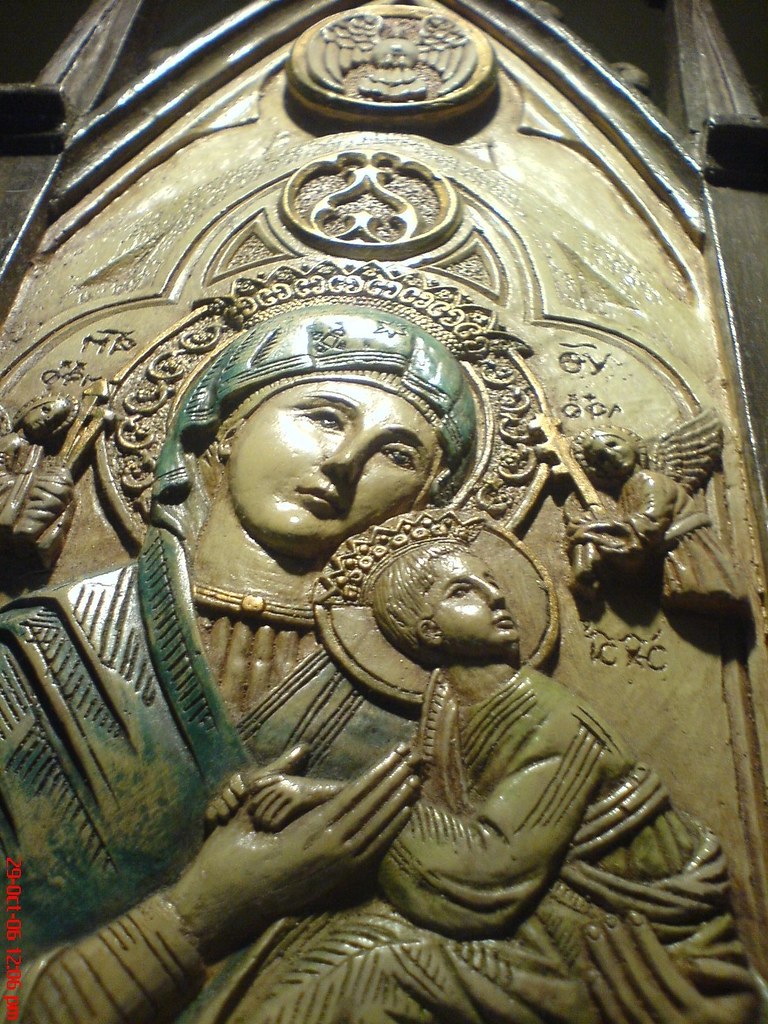May in Manila and the whole of the Philippines in general is marked by a distinctively Marian character. May is the month of Mary-- during the course of the month, thousands upon thousands from virtually all walks of life, troop to the various shrines of the Blessed Mother in this country, penitent and barefoot, carrying with them the burdens of their families and their own selves and singing and dancing their praise to the Virgin. One of the most popular shrines is that of Nuestra Señora de la Paz y Buen Viaje, Our Lady of Peace and Good Voyage, who reigns in the cathedral basilica of the Diocese of Antipolo. Said to have been miraculous, it was spirited away from an obscure parish in Acapulco by the then governor general Don Juan de Tabora during the height of the Mexico-Philippines galleon trade.
The story of how the Virgin acquired its name is the stuff of legend. As the story goes, the valiant ship El Almirante was the one favored by the governor to carry the brown Virgin back to the Philippines. During the course of the voyage, the ship was battered by endless storms and terrible winds; a fire threatened to reduce the noble ship to a pile of burnt out cinder. For three months, the ship was left alone in a cruel and unforgiving sea, with only the Virgin as their sole refuge. Eventually, the ship reached the ports of Manila in time, and miraculously intact. Governor Tabora was convinced that it was the Virgin's intercession that saved them all from a watery doom, and realizing this, called for a pompous and exceedingly grand celebration to welcome the image's arrival.
Looking at this statue of the Blessed Mother, one will note how crudely carved it is, and its rather primitive features. Indeed, many have commented that the Virgin of Antipolo resembles the Mexican indio more than it does a wealthy Spanish señora. Its eyes seem perpetually on the verge of tears, a happy accident resulting from the impervious quality of the hardwood used in its creation. Its distinctively brown skin and long, unkempt hair have, in the past, elicited derision and ridicule, even from Catholics. Her hands are half clasped, as if they longed to wrap themselves around a wayward sinner or a faithful son.
The pilgrimage to Antipolo itself is one of the most moving experiences one can have. As early as the first light of the first day of May, thousands of pilgrims descend in droves to visit the Virgin in her shrine. They come in uncounted numbers, majority of them barefoot, chanting and singing and praying and conversing amongst themselves. There are sinners among saints and saints among sinners. The penitent as well as the supplicant come together to lay their hearts at the Virgin's feet. The walk is not an easy one as well; starting from Quiapo, where the Black Nazarene is to be found (curiously, this image is also from Acapulco), the pilgrims make the arduous five hour journey to the shrine. I said in an earlier post that it took two hours at most; apparently, I was wrong. A former pastor of the Virgin of Antipolo's shrine once commented that, from the first kiss of dawn to high noon, the church was flooded by a writhing mass of humanity, and it is said that one could not walk three feet in all directions without running into another person.
The pilgrims themselves are not exactly the most stellar persons. Here perhaps is a girl, asking the Virgin to bless her relationship with a certain man whom her parents do not approve of. There perhaps is another woman, mantilla shrouding her head down to her back, walking on her knees to the Virgin while ignoring her Lord in the Blessed Sacrament. To one corner are the debauched and the thieves, in another the wrathful, the vain and the greedy. To yet another corner gather the lustful, while in another corner brood the hopeless and the abandoned. To one side waits the skeptic, to another side is the photographer who doesn't believe, while the single mother gently makes her way to the altar, her tears forming perfect beads that make up a rosary of sorrows. If you believe such things, the quickest way to have your prayer answered is to walk to the altar on one's knees fifteen times, each time praying a decade of the rosary.
Why do we do such things? Why do we persevere when almost everything around us screams at us to just give up? Looking at the Virgin, I seem to have found my answer. Her eyes that well with sorrow, her unkempt hair, her short stature, her brown skin, and her crudely carved features remind me that Mary too, was once subjected to derision. When Mary was conceiving the Lord, did her community and even close acquaintances think of her as an adulteress? When Mary was betrothed to Joseph, did her ever think the same way about her? And if that weren't enough, did she not grieve at the sight of her only Son-- bruised, bloody, beaten, flayed, ridiculed and mocked? Was not her own heart pierced with a sword? And did she not have more in common with a Dona Igñacia than she did with Isabela la Catolica?
Mary was human too, but unlike us, she never sinned. But she grieved like the rest of us, fussed over her Son like the rest of us, drank and ate like the rest of us, and slept and prayed like the rest of us. Even more important, she was also a Mother-- and the love of a mother is like the love of God-- it is unconditional, selfless, and eternal. In the teary eyes of the Virgin of Antipolo, I saw the hard work and sacrifice of my own mother, who worked day and night, sometimes till sickness, to provide us with the things we want. I saw my paternal grandmother, teaching street children in the school she helped to found. I saw my maternal grandmother, teaching her children to sing the glory of God. I saw our maid, who sometimes had to carry me to school until I was three years old.
To touch the hands of the Virgin, to touch her sacred manto in her small camarin, and to kiss her feet are the three most important things for the pilgrim to accomplish. It is not just mere veneration, but a prayer in itself; to do these things is to literally prostrate ourselves before the divine (though of course, Mary is not a goddess) and to acknowledge our sinfulness and weakness. To bargain with the Almighty is one of the most humbling acts we can ever render God; indeed, it is when we are spiritually “driest”—when we feel as if we have been abandoned by God Himself—that we are most ‘spiritual.’ It is when Jesus, His Mother by His side, kneels down once again to lend us a helping hand. When Our Lord was crucified, He did not wish for the Apostles to avenge him or to engage in aggressive polemics. He just wanted them to be there. And when Our Lord cried out, Eloi, Eloi, lama sabacthani, He too felt forsaken by God. Perhaps, were He not Divine, the weight of sin would have been too great for Him to bear. But despite all of these factors, Our Lady stood weeping by the Cross, sharing in the pain of her own Son. And it was her presence that was the sole consolation to the Lord in that hour of abandonment.
There is a story often told about a boy of seven, who had been ‘vowed’ by her mother to the Virgin of Antipolo. The boy’s mother nearly died giving birth to him, and in thanksgiving for her miraculous recovery, she made a pilgrimage to the shrine, and consecrated her son under the Virgin’s mantle. The boy spent his early years in the shadow of that church; he went there religiously and devoutly, and his learning grew and grew. Years later, as a young man in his thirties, the boy confessed that he had somehow drifted away from the Church and forgot his early pieties. But deep down, he never forgot that he was the Virgin’s own.
That man was Dr. Jose Rizal, the national hero of the Philippines. In his lifetime, Rizal was a doctor, philosopher, linguist (he spoke 22 languages, including Latin and Greek), reformist, intellectual and one time Freemason. But in the end, Rizal rediscovered his ‘covenant’ with the Virgin; and so he died, executed by the Spaniards for treason, wearing the blue sash of the one of the many pious sodalities of Our Lady. Perhaps this realization of our own humanity, and the acknowledgment of our need for redemption and forgiveness that is the greatest ‘noontime miracle’ of all.
As the sun prepares to hide its face for another day, the pilgrims assemble at the plaza to witness the procession of the image of Our Lady. She comes, bedecked in her finest gowns and jewels, borne aloft a towering carroza filled with smiling cherubs and beautiful, scented flowers. They stand in awe at her, and shout ‘Viva!’ a thousand times, the stench of sweat mingling with the salt of tears. Here, they have assembled to visit her, and she now returns to them and sees them off for another day. To the miraculous Virgin, they sing this song.

































